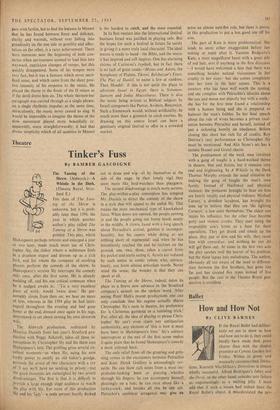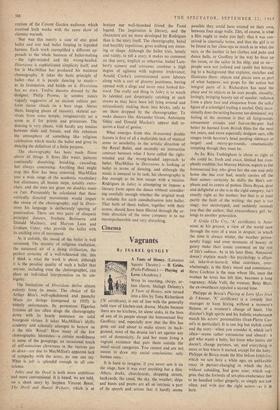Ballet
How and How Not
By CLIVE BARNES ception of the Covent Garden audience, which received both works with the same show of clammy warmth.
Nor was this merely a case of one good ballet and one bad ballet limping in lopsided harness. Each work exemplified a different ap- proach to the whole business of ballet-making —the right-minded and the wrong-headed.
Diversions is sophisticated simplicity itself, and for it MacMillan has produced his maturest choreography. It takes the basic principle of ballet—that it is people dancing to music— as its foundation, and builds on it. Diversions has no story. Twelve dancers dressed by the designer, Philip Prowse, in sombre tunics vaguely suggestive of an ancient culture per- form classic rituals on a bare stage. Above them, hanging pieces of masonry, skeletal sur- vivals from some temple, imaginatively set a scene as if for priests and priestesses. The dancing is very chaste, with hardly any tension between male and female, and this enhances the atmosphere of something like religious celebration which marks the ballet and gives its dancing the definition of a finite purpose.
The choreography has been made fluent above all things. It flows like water, patterns continually dissolving, breaking, cascading, but always continuing. Anything that might stop this flow has been removed; MacMillan uses a wide range of the academic vocabulary but eliminates all beaten steps, notably entre- chats, and the men are given no doubles tours en Pair. Presumably he calculated that these vertically directed movements would impair the sweep of the choreography, and in Diver- sions his language is deliberately sparing of punctuation. There are two pairs of eloquent , principal dancers, Svetlana Beriosova and Donald Macleary, and Maryon Lane and Graham Usher, who provide the ballet with its exciting core of movement.
As it unfolds, the mood of the ballet is well sustained. The serenity of religious exaltation, the autumnal air of a dying civilisation, the perfect certainty of a well-rehearsed rite, this I think is what the work is about, although it is the peculiar quality of such a ballet that anyone, including even the choreographer, can place an individual interpretation on its am- biguity.
The limitations of Diversions derive almost entirely from its music. The choice of Sir Arthur Bliss's well-upholstered and paunchy Music for Strings (composed in 1935) is bitterly unfortunate. Its portentous Elgarian lyricism all too often drags the choreography down with its hearty insistence on solid bourgeois virtues. It takes MacMillan's idyllic academy and solemnly attempts to bestow on it the title 'Royal.' How many of the few choreographic blemishes—a certain modishness in some of the groupings, an occasional touch of self-conscious cleverness in the various pas de deux—are due to MacMillan's apparent lack of sympathy with the score, no one can say. What is left is splendid enough in all con- science.
Jabez and the Devil is both more ambitious and more conventional. It is based, we are told, on a short story by Stephen Vincent Benet, The Devil and Daniel Webster, which is at bottom our well-thumbed friend the Faust legend. The inspiration is literary, and the characters are no more developed by Rodrigues than is the story itself. The choreography, banal and horribly repetitious, gives nothing any mean- ing or shape. Although the ballet tries, lamely and vainly, to tell a story, it makes no comment on that story, implicit or otherwise. Isabel Lam- bert's scenery and costumes combine a high degree of ugliness with supreme irrelevance; Arnold Cooke's commissioned score labours along with a sort of gloomy jauntiness, having opened with a dirge and never once looked for- ward. The really sad thing in Jabez is to watch its talented cast desperately catching at such straws as may have been left lying around and miraculously making them into bricks, only to see them dropped by the choreographer. To make dancers like Alexander Grant, Antoinette Sibley and Donald Macleary appear dull re- quires a kind of genius.
What emerges from this ill-assorted double feature is first of all a deplorable lack of musical sense or sensibility in the artistic direction of the Royal Ballet, and secondly an instructive contrast between what I have called the right- minded and the wrong-headed approach to ballet. MacMillan in Diversions is looking at ballet in terms of dancing, and although the music is unequal to its task, his choreography is fine enough to let him escape with a success. Rodrigues in Jabez is attempting to impose a literary form upon the dance without consider- ing carefully enough whether the original work is suitable for such cannibalisation into ballet. That both of these ballets, together with their scores, should have been filtered through the ar- tistic direction of the same company is to me incomprehensible and very disturbing.











































 Previous page
Previous page